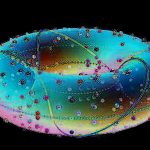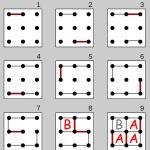Project: Exploring phase transitions and correlation inequalities through simulations
Project supervisor: Will Perkins
Description: Statistical physicists use probabilistic models to understand the behavior of gasses, fluids and solids as parameters like temperature or pressure change. Two simple mathematical models of a gas are the hard sphere and hard-core models, the first a distribution over sphere packings, the second over independent sets in a graph. This project will involve implementing several new algorithmic approaches to sampling from these probability distributions, and using the results of these simulations to understand new approaches to solving some of the important open mathematical problems in the area. Another aspect of the project will be creating useful visualizations of these statistical physics models and their related dynamics.
Outcomes:
The purpose of this project was to develop ideas and intuition for a statistical mechanics model of a gas via Markov chain Monte Carlo simulations. The focus was on the 2-d hard-core lattice gas , and in particular on understanding the curve of density vs fugacity with different boundary conditions. One motivation was to understand what inequalities might hold and to prove these inequalities in later mathematical work. One discovery was an interesting relationship between the density/fugacity curves and the system size which is indicated in the plots in the forthcoming report.
The students wrote C++ to simulate the Glauber dynamics Markov chain for the model and then develop a series of heuristics to understand how long the burn-in period should be and how many samples are required to achieve a desired level of accuracy for the given statistics. The students continued the project through the summer and are current writing the findings up as a report. They will also produce documented code with an accompanying guide so others can use the code for further experiments.
Project: The Arithmetic of Elliptic Curves from a computational point of view
Project supervisor: Evangelos Kobotis
Description: The purpose of this project is to explore the world of elliptic curves with an emphasis on their arithmetic properties via programming. Students will be introduced to the fundamental concepts of the theory of elliptic curves and will produce software that will implement these concepts. The research aspect of the project is the discovery of elliptic curves with remarkable properties.
Project: Skating through Math
Project supervisor: Abbas Jaffary
Description: In this project, students will explore the physics of roller skating, particularly on a Bank Track as shown above. There are many questions about this, including open questions. Particularly interesting are questions about the shape of the track, the paths describing motion of a skater and the most efficient path to skate around a track. Participants will explore these questions through computer simulation, along with possible trips to a roller derby track.
Outcomes: We aimed to model continuous motion in the sport of Roller Derby. There are two types of Roller Derby: Flat Track (2D) and Banked Track (3D). We rendered a full model of a Flat Track and a full model of a Banked Track. Both models were based on full scale existing tracks of the Chicago Knockouts Roller Derby league. We explored modeling with Unity, but ultimately chose SageMath for our rendering.
We began to animate differentiable, parametrized curves on both surfaces. Our goals were to model optimal paths around each track and optimize movements to improve game play. While sophisticated game play strategies have evolved empirically over the sport’s 85 year existence, it is unknown whether game play has ever been formally studied using mathematical methods.
Project: Combinatorial Game Theory
Project supervisor: Kevin Whyte
Description:
Combinatorial game theory studies deterministic, two player games of complete information. By decomposing these games into simpler pieces one gets a rich algebraic structure which is both quite useful in playing the games and has connections to the foundations of mathematics and to non-standard analysis. The theory was founded by Berlekamp, Conway, and Guy in the 1970’s and developed and applied to a wide range of games : Dots-and-Boxes, Sprouts, Nim, and others. In the 1990’s the theory was applied to the game of Go/Weiqi/Baduk by Berlekamp and Wolfe, producing problems that stumped professional players in China, Japan, and Korea. Open problems remain for a large variety of games, and we will explore many of these as well as develop new examples and applications.




